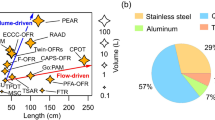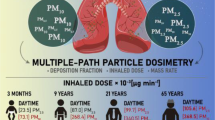Abstract
Rats were exposed to white smoke generated from mixtures of titanium dioxide-hexachloroethane (TiO2-HC) and zinc-hexachloroethane (Zn-HC), respectively, in an inhalation chamber operated in the static mode. The dose was varied by varying the amount of smoke mixture and/or the exposure time. The acute inhalation toxicity of TiO2-HC smoke was much lower than the Zn-HC smoke. Thus, the animals survived exposure to TiO2-HC smoke, even at relatively high smoke concentrations. This smoke was irritating to the animals and minor, acute inflammatory changes were seen in lung tissue. In contrast, Zn-HC smoke was very toxic and caused lethal injuries to the experimental animals, even at relatively low concentrations. Pulmonary injuries were extensive and death was due to blood congestion with pulmonary oedema. Since the TiO2-HC and Zn-HC mixtures form TiCl4 and ZnCl2, respectively, a separate study was performed in which rats were exposed to TiCl4 gas or ZnCl2 aerosol. No animals died from exposure to TiCl4 at concentrations between 370 and 2900 mg/m3 for 10 min. The LC50 of ZnCl2 was found to be around 2000 mg/m3 during a 10-min exposure period. The difference between the two types of smoke is explained by the difference in toxicity between TiCl4 and ZnCl2.
Similar content being viewed by others
References
Ardran GM (1950) The pulmonary effects of toxic gases and smokes. An experimental radiographic investigation. Br J Radiol 23: 107–115
Åkhagen R (1973) Röksats. Swedish Patent No SE 359289
Cotton FA, Wilkinson G (1962) Advanced inorganic chemistry. A comprehensive text. Interscience Publishers, USA
Cullumbine H (1957) The toxicity of screening smokes. J R Army Med Corps 103: 119–122
Evans EH (1945) Casualties following exposure to zinc chloride smoke. Lancet 2: 368–370
Fischer H (1969) Accidents caused by combat and smoke chemicals and their sequelae. Pathological-anatomical contribution. Wehrmed Monatsschr 13: 355–359
Fischer H (1974) Morphologie der Zinknebelvergiftung der Lunge. Pneumonologie 150: 171–172
Hedener B (1957) Förgiftning genom rökgas. Tidskr Mil Hälsovård 82: 87–89
Heimbürger G (1977) Toxikologisk undersökning av zinkoch titanröksatser. En litteraturstudie. FOA-rapport C 40072-H2
Helm KU, Renovanz H-D, Schmal K, von Clarmann M (1971) Zinc cloride smoke poisoning and its treatment. II. Symptomatology and progress of the poisoning. Wehrmed Monatsschr 15: 203–217
Johnson FA, Stonehill RB (1961) Chemical pneumonitis from inhalation of zinc chloride. Dis Chest 40: 619–624
Karlsson N, Cassel G, Fängmark I, Bergman F (1984) The inhalation toxicity of screening smoke. XIth International Congress of the European Association of Poison Control Centres, Stockholm, Sweden, June 17–20
Kelly DP, Lee KP, Burgess BA (1981) Inhalation toxicity of titanium tetrachloride atmospheric hydrolysis products. Toxicologist 1: 76
Linderholm H, Strandberg O (1956) Lungskador i samband med rökgasexposition. Tidskr Mil Häsovård 81: 229–241
Lumsden RB, Weir CD (1945) Subglottic stenosis after exposure to a high concentration of screening smoke (zinc chloride). Br Med J 1: 554–555
MacAuley MB, Mant AK (1964) Smoke-bomb poisoning. A fatal case following the inhalation of zinc chloride smoke. J R Army Med Corps 110: 27–32
Marrs TC, Clifford WE, Colgrave HF (1983) Pathological changes produced by exposure of rabbits and rats to smokes from mixtures of hexachloroethane and zinc oxide. Toxicol Lett 19: 247–252
Mercer TT (1973) Aerosol technology in hazard evaluation. Academic Press, New York
Mezentseva NV, Melinkova EA, Mogilevskaya OY (1963) Experimental studies on the effect on the organism of rare, dispersed and other metals and their compounds used in industry; Titanium. In: Izraelson ZI (ed) Toxicology of the rare metals. Gosudarstvennoe Izdatel'stvo Meditsinskoi Literatury, Moskva. English translation available from NTIS (AEC TR 6710)
Milliken JA, Waugh D, Kadish ME (1963) Acute interstitial pulmonary fibrosis caused by a smoke bomb. Can Med Assoc J 88: 36–39
Mitchell RI, Pilcher JM (1959) Improved cascade impactor for measuring aerosol particle size in air pollutants, commercial aerosols, cigarette smoke. Ind Eng Chem 15: 1039–1042
Norberg B, Landström-Hyden H (1942) Rapport rörande jämförande toxicitetsprövning av armens rökmateriel och viss ny rökmateriel. Rapport från Försvarets Kemiska Anstalt, dnr 458/82
Pare CMB, Sandler M (1954) Smoke-bomb pneumonitis: description of a case. J R Army Med Corps 100: 320–322
Raabe OG (1976) The generation of aerosols of fine particles. In: Liu BYH (ed) (Fine particles. Aerosol generation, measurements, sampling and analyses) cademic Press, New York
Reaves WW, Carlon KG (1961) Comparison of dechlorane and hexachloroethane in smokescreen compositions. CRDL Special Publication, AD 266364
Saffiotti U, Cefis R, Kolb LH (1968) A method for the experimental induction of bronchogenic carcinoma. Cancer Res 28: 104–124
Sax I (1979) Dangerous properties of industrial materials, van Nostrand Reinhold Company, New York
Whitaker PH (1945) Radiological appearances of the chest following partial asphyxiation by a smoke screen. Br J Radiol 18: 396–397
Author information
Authors and Affiliations
Rights and permissions
About this article
Cite this article
Karlsson, N., Cassel, G., Fängmark, I. et al. A comparative study of the acute inhalation toxicity of smoke from TiO2-hexachloroethane and Zn-hexachloroethane pyrotechnic mixtures. Arch Toxicol 59, 160–166 (1986). https://doi.org/10.1007/BF00316326
Received:
Accepted:
Issue Date:
DOI: https://doi.org/10.1007/BF00316326




